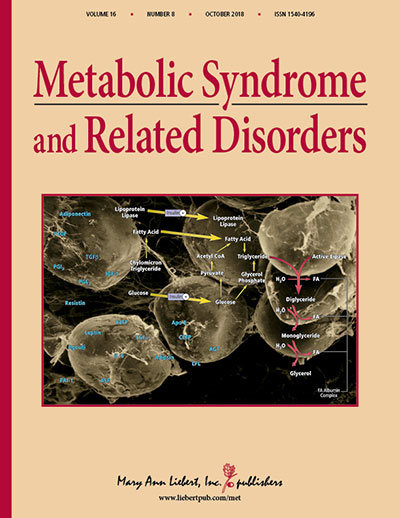For Immediate Release
What are the Determinants Associated with Fasting Hyperglucagonemia in Type 2 Diabetes?
Contact: Kathryn Ryan
914-740-2250
kryan@liebertpub.com

New Rochelle, NY, October 23, 2018—A new study examined the relationship between fasting hyperglucagonemia — which can negatively affect glucose metabolism in patients with type 2 diabetes (T2D) — and several biochemical and glycemic factors in subjects with T2D or in a nondiabetic control group. The study results, which help to elucidate the mechanisms that underlie fasting hyperglucagonemia, are published in Metabolic Syndrome and Related Disorders, a peer-reviewed journal from Mary Ann Liebert, Inc., publishers. Click here to read the full-text article free on the Metabolic Syndrome and Related Disorders website through November 23, 2018.
Filip Knop, Steno Diabetes Center Copenhagen, University of Copenhagen, and Faculty of Health and Medical Sciences, University of Copenhagen, Denmark, and a team of researchers coauthored the article entitled “Determinants of Fasting Hyperglucagonemia in Patients with Type 2 Diabetes and Non-Diabetic Control Subjects.” The researchers looked at a broad range of factors including body mass index, fasting plasma glucose, hemoglobin A1c, insulin concentrations, and waist-to hip ratio (WHR).
Patients with T2D had significantly higher fasting plasma glucagon concentrations. Further analysis showed that important determining factors within this T2D group were WHR as well as glycemic control and fasting plasma insulin concentrations. These findings suggest a role for visceral fat deposition in increased fasting plasma glucagon concentrations. The researchers report that WHR is a determinant of fasting hyperglucagonemia in both patients with T2D and nondiabetic subjects.
“Glucagon is the neglected glucoregulatory hormone in type 2 diabetes – mainly because its dysregulation is considered to be secondary to defects in insulin secretion. There is increasing evidence that abnormal glucagon secretion occurs early in the pathogenesis of diabetes. This paper together with a few others suggests that defects in insulin action contribute to this dysregulation,” says Dr. Adrian Vella, Editor-in-Chief of Metabolic Syndrome and Related Disorders and Professor, Mayo Clinic College of Medicine, Rochester, MN.
About the Journal
Metabolic Syndrome and Related Disorders is the only peer-reviewed journal to focus solely on the pathophysiology, recognition, and treatment of metabolic syndrome. Led by Adrian Vella, MD, FRCP (Edin.), Professor of Medicine, Endocrinology, Diabetes, Metabolism, and Nutrition, Mayo Clinic College of Medicine, Rochester, MN, the Journal covers a range of topics including insulin resistance, central obesity, glucose intolerance, dyslipidemia with elevated triglycerides, predominance of small dense LDL-cholesterol particles, hypertension, endothelial dysfunction, and oxidative stress and inflammation. Complete tables of content and a sample issue may be viewed on the Metabolic Syndrome and Related Disorders website.
About the Publisher
Mary Ann Liebert, Inc., publishers is a privately held, fully integrated media company known for establishing authoritative peer-reviewed journals in many promising areas of science and biomedical research, including Childhood Obesity, Diabetes Technology and Therapeutics, and Thyroid. Its biotechnology trade magazine, GEN (Genetic Engineering & Biotechnology News), was the first in its field and is today the industry’s most widely read publication worldwide. A complete list of the firm’s 80 journals, newsmagazines, and books is available on the Mary Ann Liebert, Inc., publishers website.